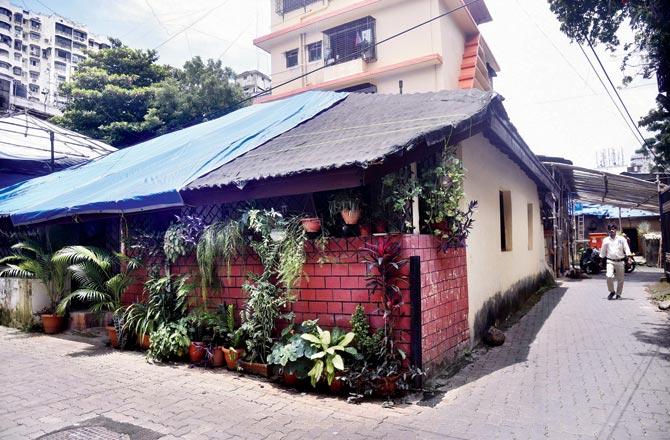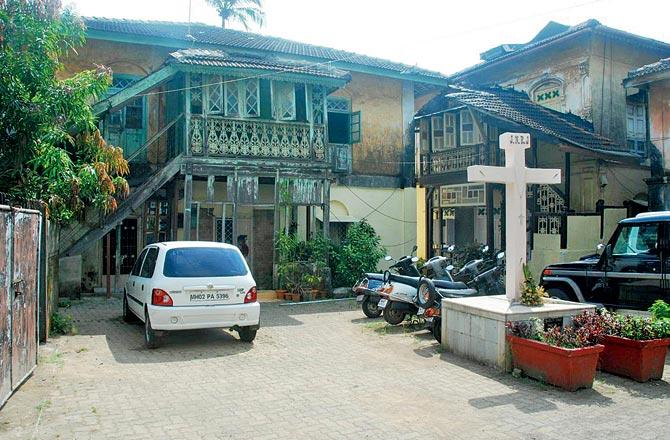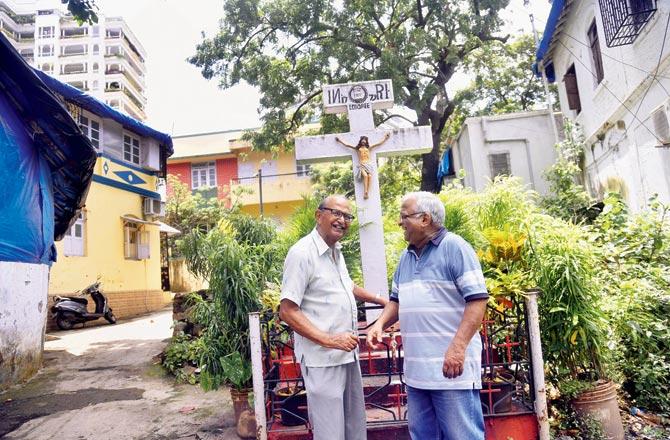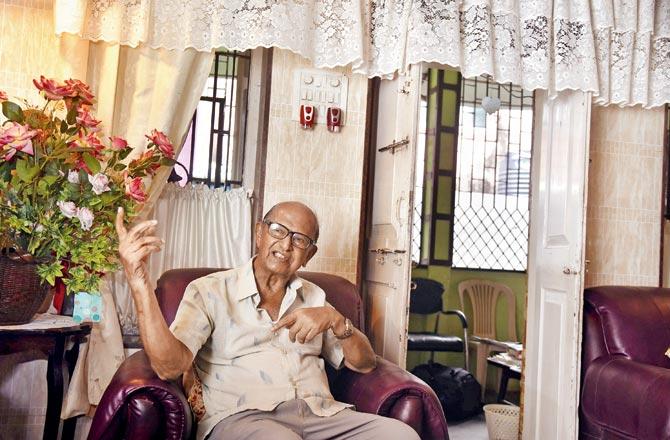Forming one of Bombay's earliest ethno-religious communities, East Indian villagers in and around Bandra get ready to celebrate the September 8 Feast of the Basilica of Our Lady of the Mount

Cecy Drego fronts 'Lester's Grotto' opposite her Pali village home
 Once there were green fields kissed by the sun," declared Fr Larry Pereira, in Explorer, the Bombay Local History Society magazine. The late priest's account lauded the lush southwest seclusion of Salsette Island. Paddy fields, vegetable patches and coconut groves, called oarts, sparkled on the slopes of Bandra's hills—Mount Mary and Pali.
Once there were green fields kissed by the sun," declared Fr Larry Pereira, in Explorer, the Bombay Local History Society magazine. The late priest's account lauded the lush southwest seclusion of Salsette Island. Paddy fields, vegetable patches and coconut groves, called oarts, sparkled on the slopes of Bandra's hills—Mount Mary and Pali.
Some years before I set off exploring Bandra's villages this time round, Fr Larry had walked me through his ancestral Ranwar. He explained how abundant agricultural acres, fruit orchards and saltpans sprouted villages called gaothans. Inhabitants of over 15 from 25 of these were farmers, the rest toddy tappers, potters and fishermen selling anna-worth pomfrets which were dried, fried, pickled or curried.
ADVERTISEMENT

Some crosses and grottos familiarly refer to the residents of East Indian cottages these were raised beside. Pics/Pradeep Dhivar
Villages like Ranwar, Boran, Pali, Chuim, Chimbai, Sherly and Rajan were exclusively East Indian. From the 15th and 16th centuries, Franciscan and Jesuit missionaries embarked on conversions in rural Salsette. Those calling themselves "East Indians" did not want the British government to confuse "native settlers" like themselves with Christians from Goa, Kerala and Karnataka. These cultivators turned English-educated landowners, clerks and officers with shipping companies. Asserting a distinct identity, they formed the Bombay East Indian Association in 1887. A post-war building boom accommodated more migrants, some of whose attics still store harvesting implements, chintzy crockery and even the remnant of a Greek monograph on Christ.
"Best to say we're Maharashtrian Catholics," laughs retired banker Cecy Drego, agreeing too many ask, mystified, "Who are East Indians?" Stepping out of low-roofed Cottage No. 55 in Pali, spilling with plants that curtain it green, she shouts "Tutu! Tutu!" Till Titus Fernandes, from No. 16 appears. He and his sister Jean are descendants of Marol landowners shifting here in the 1930s.

Scene in a typical Ranwar village courtyard. The Portuguese-influenced domestic architecture of homes like this is fast falling off the city map. Pic/Gitanjali Mehta Anand
That was when residents hopped on to the solitary bus plying the village green from Pali Naka to the train station. Chuim had only one car, Uncle Alfie's jalopy nicknamed Valkee by children. They declined rides in it, preferring to run on paths that hid courting couples on Sherly-Rajan beach sands and Danda Green’s 9-hole golf course.
"Come back when the feast livens up our little gullies," Cecy invites. This lasts eight days, from the Sunday after September 8, the birthday of Mother Mary, to the next, termed Octave Sunday. The date falling on a Sunday, this year's Feast starts on the 8th itself. The Bandra Fair envelopes the Basilica of Our Lady of the Mount, designed Neo-Gothic by Shapoorjee Chandabhoy.

Desmond Fernandes and Rudy Alves in front of the 1779-built Cross at Chuim outside Fernandes' home
The shrine attracted devotees in bullock carts and boats across Mahim creek. A 1669 document mentions bell-jingling recklas (decorated carts) carrying passengers to the foot of the Mount by the light of lanterns. After their tiring trip from gaothans beyond Bandra, bullocks were tethered in cool mango groves to drink water while the faithful trekked up to worship.
Returning, pilgrims partook of tea and snacks locals kept ready on road-jutting verandas. Simple diversions for visiting relatives and friends graduated to "Funny Mirror" stalls and giant wheels dizzying us as kids. We were in awe of older schoolmates jiving with long-haired boys at jam sessions in the fair's "September Garden".

Fernandes at his cottage, Louis Ville
East Indian bands strike up mournful to merry tunes, the occasion mandating funereal solemnity or festive gaiety. "Like brass bands, they play Koli songs including 'Galyan sankli sonachi' and 'Garavati'," says Denise D'Abreo from Pali. "These are in Khar, Kurla, Kirol... Bandra's Bazar Road and Chimbai groups are in big demand." Garavati derives from "ghara varti (top of the house)". The line, "Garavati, garavati, sonachi kavla garavati" translates as "Golden tiles on my rooftop". East Indian Marathi is a fast dying dialect heard in Uttan, Marol, Manori, Culvem, Gorai and Vasai gaothans.
Past pebbled grottos, we reach SAISA (St Anthony's Institute Sports Academy), the school-turned-club with a swimming pool. Football, cricket, tennis and badminton champs apart, every village produces musicians. Pali claims keyboardist Beven Fonseca. "Music and hunting were our forefathers' passions," Cecy says, thumbing open an album of shikaar photos. Hoisting double-barrelled guns, they headed to spot game in the thickets of Bandra East and Badlapur.
Among the music men of Chuim, off Ambedkar Road further north, is jazz pianist Xavier Fernandes. His violinist father Sebastian performed with the Bombay Symphony Orchestra, filmmaker Sorab Modi, and music directors C Ramachandra and Laxmikant Pyarelal.
I get a potted history of Chuim in Louis Ville, built by Desmond Fernandes' grandfather in 1934. With us is Rudy Alves from No. 1 A—built over a century ago by his great-grandfather Daniel, this cottage demarcates the start of their village. His humourist uncle Johnny Alves authored Eve's Weekly's 1970s column, "Hi Ya Honey, from an Alves called Johnny". The Chuim Reading Room and Sporting Club building was given in 1943 to St Vincent de Paul Church. “Our parish children keep alive the custom of Intruz, going from house to house seeking the blessings of elders on Shrove Tuesday during the season of Lent,” Desmond says. "Fishing jamborees announced by the village crier were popular affairs," adds Rudy, who researches and writes books on the city's East Indian bastions.
With the two neighbours I reach a cross on the road outside, dated 1779. Its inscription seems Armenian. "That's probable because the Armenians were excellent masons and carvers," says Zameer Basrai of The Busride Design Studio in Ranwar. The Dollhouse Project he and his brother Ayaz have created offers miniature models of St Andrew's Church and the Oratory near Jude Bakery. The idea engages the interest of a younger following with such iconic structures.
In different villages, relics familiarly christened Romeo's Cross and Lester's Grotto, among others, refer to whose cottage a cross abuts. The initials INRI spell: Iesus Nazarenus Rex Iudaeorum (Jesus of Nazareth, King of the Jews). The shortest stroll on a main road reveals purposefully placed "plague crosses", erected to ward off the disease and remember its victims.
In the 1890s, sleepy Bandra's population spiked post-bubonic plague attacks in the overcrowded island city people moved away from. Though crosses were raised before the end-1800s and early 1900s, those years of "the black death" upped cross construction. The pride of Boran was the Almeidas' heritage wooden cross of 1854. Built to protect their hamlet—also that of the Correia, Henriques and D'Joss families—its marble base is a feature from this vintage treasure's centenary year.
"My mother was a D'Joss from Boran," says 93-year-old Marie D'Souza, imperially, on the porch of Ed-Mar, the prettiest home in Ice Factory Lane. Her father, Ignatius D'Monte, was President of Bandra Municipality. The separate municipality merged in 1957 with BMC. "East Indian culture is part Portuguese, Maharashtrian and English, with a touch of the Goan. But nothing matches East Indian sweets," she says, reeling off a scrumptious list of desserts and savouries, from fugia bread balls and dosa-type chityaps, to vegetable foogath, spicy frithad and chinchoni curries. I leave sniffing the East Indian aromatic bottle masala, blending 30 sun-curled, roasted spices with raw gram, chillies and white pepper.
Ice Factory Lane lies off Hill Road. My alma mater stands in the middle of this arterial street. An announcement for sports practice, on the brick walls of St Joseph's School, evokes memories of the first Indian woman at the Olympics—Mary D'Souza, student and hockey teacher at the school, who made Rajan village her home since 1958. Representing the country at Helsinki in 1952, she lacked a coach, not determination. St Joseph's had no field for the track events ace. At night she jumped walls to train on St Andrew's ground next door because then girls could not train with boys.
The Waroda Road junction facing St Andrew's Church leads to uncountable lime-washed crosses in Ranwar. Here lie red-roofed villas that time forgot, with double windows, diamond-pattern ventilators and cemented balcony seats which were focal meeting points. This fine domestic architecture has fallen prey to galloping builder greed, eroding the villages' unique pedestrian scale and communicative quality.
Pipe-puffing parishioners loll away slow afternoons. Hard to imagine they once energetically chased hens and pigs across village squares. Fattened for sale, pigs were fed starchy diets by housewives ambling down alleys with rice soup pails balanced on their heads. Goats, turkeys, guinea fowl—and cookery recipes—were prized dowry items. Nuptials were weeklong whirls with whole villages showing up, says Marie Concessio, who produced calendars on East Indian traditions. Her 2011 theme was weddings.
An East Indian wedding brought a delight a day. Kicking off the robust revelry, Thursday was for pig slaughter, Friday for pounding paapads as snacks with drinks. Saturday saw water drawn from the well—"umbracha pani"—to bathe both bride and groom—in a procession of Koli-style dancers twirling handkerchiefs overhead. Sunday dawned for the ceremony with a band tooting as the young man went to church under a "Satir" umbrella, before sending it for his bride. Monday was to finish feasting on the previous night's pork and wine. On Tuesday guests' feet were washed and a farewell dinner on Wednesday preceded Goodbye Thursday.
Grande dame Marie D'Souza has her final say-so: "Since Bombay became Mumbai, it has deteriorated." But village Bandra holds on to uncommon hope. Hospitable cottagers warmly tell me, "You have a date with us on September 8." I'm going to keep it.
Author-publisher Meher Marfatia writes fortnightly on everything that makes her love Mumbai and adore Bombay. You can reach her at mehermarfatia@gmail.com/
www.mehermarfatia.com
Catch up on all the latest Crime, National, International and Hatke news here. Also download the new mid-day Android and iOS apps to get latest updates
 Subscribe today by clicking the link and stay updated with the latest news!" Click here!
Subscribe today by clicking the link and stay updated with the latest news!" Click here!







